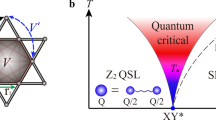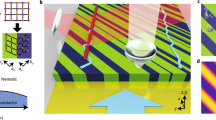Abstract
Electrons in semiconductors usually behave like a gas—as independent particles. However, when confined to two dimensions under a perpendicular magnetic field at low temperatures, they condense into an incompressible quantum liquid. This phenomenon, known as the fractional quantum Hall (FQH) effect1, is a quantum-mechanical manifestation of the macroscopic behaviour of correlated electrons that arises when the Landau-level filling factor is a rational fraction. However, the diverse microscopic interactions responsible for its emergence1,2 have been hidden by its universality and macroscopic nature3,4,5,6,7,8,9. Here, we report real-space imaging of FQH liquids, achieved with polarization-sensitive scanning optical microscopy using trions (charged excitons)10,11,12,13,14,15 as a local probe for electron spin polarization. When the FQH ground state is spin-polarized, the triplet/singlet intensity map exhibits a spatial pattern that mirrors the intrinsic disorder potential, which is interpreted as a mapping of compressible and incompressible electron liquids. In contrast, when FQH ground states with different spin polarization coexist, domain structures with spontaneous quasi-long-range order emerge, which can be reproduced remarkably well from the disorder patterns using a two-dimensional random-field Ising model16. Our results constitute the first reported real-space observation of quantum liquids in a class of broken symmetry state known as the quantum Hall ferromagnet17,18,19,20,21,22,23,24,25.
This is a preview of subscription content, access via your institution
Access options
Subscribe to this journal
Receive 12 print issues and online access
$259.00 per year
only $21.58 per issue
Buy this article
- Purchase on Springer Link
- Instant access to full article PDF
Prices may be subject to local taxes which are calculated during checkout




Similar content being viewed by others
References
Tsui, D. C., Stormer, H. L. & Gossard, A. C. Two-dimensional magnetotransport in the extreme quantum limit. Phys. Rev. Lett. 48, 1559–1562 (1982).
Von Klitzing, K., Dorda, G. & Pepper, M. New method for high-accuracy determination of the fine-structure constant based on quantized Hall resistance. Phys. Rev. Lett. 45, 494–497 (1982).
Yacoby, A., Hess, H. F., Fulton, T. A., Pfeiffer, L. N. & West, K. W. Electrical imaging of the quantum Hall state. Solid State Commun. 111, 1–13 (1999).
Morgenstern, M., Klijn, J., Meyer, C. & Wiesendanger, R. Real-space observation of drift states in a two-dimensional electron system at high magnetic fields. Phys. Rev. Lett. 90, 056804 (2003).
Niimi, Y., Kambara, H., Matsui, T., Yoshioka, D. & Fukuyama, H. Real-space imaging of alternate localization and extension of quasi-two-dimensional electronic states at graphite surfaces in magnetic fields. Phys. Rev. Lett. 97, 236804 (2006).
Hashimoto, K. et al. Quantum Hall transition in real space: from localized to extended states. Phys. Rev. Lett. 101, 256802 (2008).
Song, Y. J. et al. High-resolution tunnelling spectroscopy of a graphene quartet Nature 467, 185–198 (2010).
Ilani, S. et al. The microscopic nature of localization in the quantum Hall effect. Nature 427, 328–332 (2004).
Martin, J. et al. Localization of fractionally charged quasi-particles. Science 305, 980–983 (2004).
Kheng, K. et al. Observation of negatively charged excitons X− in semiconductor quantum wells. Phys. Rev. Lett. 71, 1752–1755 (1993).
Finkelstein, G., Shtrikman, H. & Bar-Joseph, I. Optical spectroscopy of a two-dimensional electron gas near the metal–insulator transition. Phys. Rev. Lett. 74, 976–979 (1995).
Shields, A. J., Pepper, M., Simmons, M. Y. & Ritchie, D. A. Spin-triplet negatively charged excitons in GaAs quantum wells. Phys. Rev. B 52, 7841–7844 (1995).
Yusa, G., Shtrikman, H. & Bar-Joseph, I. Charged excitons in the fractional quantum Hall regime. Phys. Rev. Lett. 87, 216402 (2001).
Plochocka, P. et al. Optical absorption to probe the quantum Hall ferromagnet at filling factor ν = 1. Phys. Rev. Lett. 102, 126806 (2009).
Wojs, A. & Quinn, J. J. Energy spectra of fractional quantum Hall systems in the presence of a valence hole. Phys. Rev. B 63, 045303 (2000).
Pelissetto, A. & Vicari, E. Critical phenomena and renormalization-group theory. Phys. Rep. 368, 549–727 (2002).
Jungwirth, T. & MacDonald, A. H. Pseudospin anisotropy classification of quantum Hall ferromagnets. Phys. Rev. B 63, 035305 (2000).
Nomura, K. & MacDonald, A. H. Quantum Hall ferromagnetism in graphene. Phys. Rev. Lett. 96, 256602 (2006).
Piazza, V. et al. First-order phase transitions in a quantum Hall ferromagnet. Nature 402, 638–641 (1999).
Eom, J. et al. Quantum Hall ferromagnetism in a two-dimensional electron system. Science 289, 2320–2323 (2000).
Smet, J. H., Deutschmann, R. A., Wegscheider, W., Abstreiter, G. & von Klitzing, K. Ising ferromagnetism and domain morphology in the fractional quantum Hall regime. Phys. Rev. Lett. 86, 2412–2415 (2001).
De Poortere, E. P., Tutuc, E., Papadakis, S. J. & Shayegan, M. Resistance spikes at transitions between quantum Hall ferromagnets. Science 290, 1546–1549 (2000).
Kumada, N., Muraki, K. & Hirayama, Y. Low-frequency spin dynamics in a canted antiferromagnet. Science 313, 329–332 (2006).
Weitz, R. T., Allen, M. T., Feldman, B. E., Martin, J. & Yacoby, A. Broken-symmetry states in doubly gated suspended bilayer graphene. Science 330, 812–816 (2010).
Verdene, B. et al. Microscopic manifestation of the spin phase transition at filling factor 2/3. Nature Phys. 3, 392–396 (2007).
Chklovskii, D. B. & Lee, P. A. Transport properties between quantum Hall plateaus. Phys. Rev. B 48, 18060–18078 (1993).
Eytan, G., Yayon, Y., Rappaport, M., Strikman, H. & Bar-Joseph, I. Near-field spectroscopy of a gated electron gas: a direct evidence for electron localization. Phys. Rev. Lett. 81, 1666–1669 (1998).
Shibata, N. & Nomura, K. Phase separation in ν = 2/3 Fractional quantum Hall systems. J. Phys. Soc. Jpn 76, 103711 (2007).
Jain, J. Composite Fermions (Cambridge Univ. Press, 2007).
Imbrie, J. Z. Lower critical dimension of the random-field Ising model. Phys. Rev. Lett. 53, 1747–1750 (1984).
Acknowledgements
The authors thank K. Takashina, H. Akiyama, Y. Toda, K. Akiba, N. Kumada, T. D. Rhone, W. J. Munro, T. Fujisawa, N. Shibata, A. Hosoya and H. Sakaki for fruitful discussions and M. Ueki for experimental support. This work was supported by a Grant-in-Aid for Scientific Research (nos. 21241024 and 24241039) from the Ministry of Education, Culture, Sports, Science and Technology (MEXT), Japan, and by the Japan Science and Technology Agency, PRESTO. J.H. was supported by a Grant in-Aid from the Tohoku University International Advanced Research and Education Organization.
Author information
Authors and Affiliations
Contributions
J.H. contributed to the experimental set-up and measurements. J.H. and G.Y. contributed to data analysis and numerical calculations. K.M contributed to material growth. G.Y. wrote the manuscript, with feedback from all authors.
Corresponding author
Ethics declarations
Competing interests
The authors declare no competing financial interests.
Supplementary information
Supplementary information
Supplementary information (PDF 653 kb)
Rights and permissions
About this article
Cite this article
Hayakawa, J., Muraki, K. & Yusa, G. Real-space imaging of fractional quantum Hall liquids. Nature Nanotech 8, 31–35 (2013). https://doi.org/10.1038/nnano.2012.209
Received:
Accepted:
Published:
Issue Date:
DOI: https://doi.org/10.1038/nnano.2012.209
This article is cited by
-
Signatures of fractional quantum anomalous Hall states in twisted MoTe2
Nature (2023)
-
Spin phase diagram of the interacting quantum Hall liquid
Nature Physics (2020)
-
Nonlinear optics in the fractional quantum Hall regime
Nature (2019)
-
Scanning nuclear resonance imaging of a hyperfine-coupled quantum Hall system
Nature Communications (2018)



